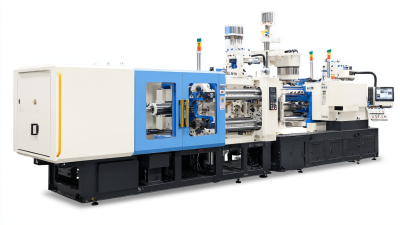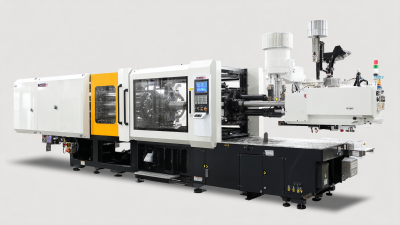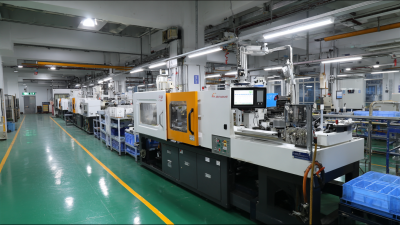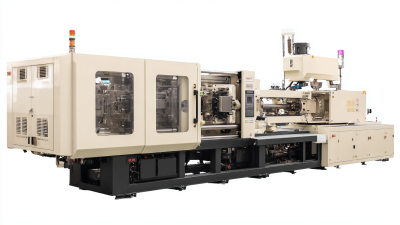Maximizing Production Efficiency with Advanced Plastic Molding Machines
In an era where efficiency and sustainability are paramount, the role of technology in manufacturing cannot be overstated. The global plastic molding machine market is projected to reach USD 45.73 billion by 2026, growing at a CAGR of 5.2% from 2021 to 2026, as reported by industry analysts. This growth is driven by the increasing demand for high-quality, cost-effective solutions in sectors ranging from automotive to consumer goods. Advanced plastic molding machines, equipped with state-of-the-art automation and IoT capabilities, are revolutionizing production lines by minimizing waste and optimizing cycle times. By adopting these technologies, manufacturers can significantly enhance their production efficiency and competitiveness in a rapidly evolving market landscape. As industries look for innovative ways to meet consumer demands while maintaining operational excellence, leveraging cutting-edge plastic molding machines becomes essential for success.

Benefits of Advanced Plastic Molding Machines in Modern Manufacturing
Advanced plastic molding machines have become essential in modern manufacturing, significantly contributing to increased production efficiency. According to a recent report by Market Research Future, the global plastic molding market is projected to reach USD 780 billion by 2025, driven by the demand for lightweight and durable products. These machines offer enhanced precision and repeatability, which reduces material waste and improves product quality. For instance, the introduction of servo-driven technology has increased the energy efficiency of molding processes by up to 50%, highlighting the environmental and economic benefits of adopting advanced machinery.

Furthermore, the integration of automation and smart technology in plastic molding has redefined operational capabilities. The use of advanced robotics not only speeds up the production cycle but also minimizes labor costs. A study by Allied Market Research indicates that automation in manufacturing can reduce operational costs by up to 30%. As manufacturers strive to meet the growing demand for just-in-time production, advanced plastic molding machines are vital in achieving rapid turnaround times without compromising quality. This shift not only enhances competitiveness but also aligns with sustainability goals, making advanced machines a cornerstone of modern manufacturing strategies.
Key Features That Enhance Production Efficiency in Molding Technology
Advanced plastic molding machines are revolutionizing the manufacturing landscape by integrating innovative features that significantly enhance production efficiency. One of the key features is the implementation of smart automation systems. These systems utilize sensors and real-time data analytics to monitor the molding process, allowing for immediate adjustments that minimize defects and reduce production time. By optimizing each phase of the molding cycle, manufacturers can increase output while maintaining high-quality standards.
Another crucial aspect is the energy efficiency of these machines. Modern molding technologies are designed to consume less power without sacrificing performance. Features such as servo-driven hydraulic systems and energy recovery mechanisms not only lower operational costs but also support sustainability goals by reducing the carbon footprint of production processes. Coupled with superior thermal management capabilities, these advancements ensure that machines can operate at peak efficiency, further enhancing their production capabilities. Hence, by leveraging these advanced features, manufacturers can maximize productivity and stay competitive in a fast-evolving market.
Innovative Techniques for Reducing Waste in Plastic Production
Innovative techniques for reducing waste in plastic production are essential for enhancing overall production efficiency. According to the Plastics Industry Association, the global demand for plastic is expected to reach 500 million metric tons by 2025, making it crucial to adopt sustainable practices that minimize environmental impacts. Advanced plastic molding machines are now designed with integrated waste-reduction capabilities, employing real-time monitoring and analytics to optimize material use during the molding process.
One key technique gaining traction is the implementation of closed-loop recycling systems. These systems utilize scrap material from production processes and reintroduce it back into the production cycle, significantly reducing the need for virgin materials. A study by the American Chemistry Council indicates that such practices can decrease energy consumption by up to 30% and reduce greenhouse gas emissions by 25%. Furthermore, enhancements in machine precision and rapid tooling technology not only streamline operations but also promote better material flow, thus minimizing defects and reducing scrap rates. By leveraging these innovative methodologies, manufacturers can simultaneously boost efficiency and contribute to a more sustainable future in plastic production.
Maximizing Production Efficiency with Advanced Plastic Molding Machines
| Machine Model | Production Rate (units/hour) | Energy Consumption (kWh) | Waste Reduction (%) | Maintenance Cost ($/year) |
|---|---|---|---|---|
| Model A | 250 | 20 | 30 | 1500 |
| Model B | 300 | 25 | 28 | 1200 |
| Model C | 200 | 22 | 35 | 1300 |
| Model D | 280 | 18 | 25 | 1400 |
Integrating Automation and Robotics into Plastic Molding Processes
The integration of automation and robotics into plastic molding processes is revolutionizing the manufacturing landscape, enhancing both efficiency and precision. By incorporating advanced robotics, manufacturers can streamline their production lines, reducing manual labor and minimizing human error. Automated systems can undertake tasks such as loading raw materials, operating molding machines, and handling finished products. This not only speeds up the production cycle but also enables a more consistent quality of output, ultimately leading to higher customer satisfaction.
Moreover, the synergy between automation technology and plastic molding machines allows for real-time monitoring and adjustments. Smart sensors can collect data on various parameters during the molding process, such as temperature and pressure, ensuring optimal conditions are maintained. This data-driven approach facilitates predictive maintenance, which can drastically reduce downtime and increase overall productivity. By leveraging these advanced technologies, factories can not only maximize their production capacity but also adapt swiftly to changing market demands, making them more competitive in a fast-evolving industry.

Case Studies: Real-World Examples of Efficiency Gains in Production Lines
In the modern manufacturing landscape, advanced plastic molding machines are revolutionizing production efficiency. One notable case study involves a leading automotive parts manufacturer that integrated a new high-speed injection molding system into their production line. By optimizing the cycle time and reducing material waste, the company reported a remarkable 30% increase in output within the same time frame. This not only enhanced their productivity but also significantly lowered costs, allowing them to reinvest savings into further technological advancements.
Another compelling example comes from a consumer goods company that adopted robotic-assisted molding machines. By automating the loading and unloading processes, they decreased human error and minimized downtime. The results were impressive: a 25% reduction in production lead times and an increase in product consistency. This shift not only met the rising demand for their products but also improved overall quality, showcasing how investing in advanced molding technology can yield substantial benefits across various sectors.
Maximizing Production Efficiency with Advanced Plastic Molding Machines
This chart illustrates the improvement in production efficiency (measured in units produced per hour) after the implementation of advanced plastic molding machines in production lines. The data highlights the performance before and after the technology upgrade.
Related Posts
-

How to Choose the Right Moulding Plastic Machine for Your Manufacturing Needs
-

Global Quality Revolution How Chinese Moulding Plastic Machines Capture International Markets
-

How to Choose the Best Home Plastic Injection Molding Machine for Your DIY Projects
-

Exploring Innovative Alternatives to Plastic Injection Machines for Modern Manufacturing
-

Evaluating the Best Large Injection Molding Machines for Global Buyers in 2025 Industry Trends and Insights
